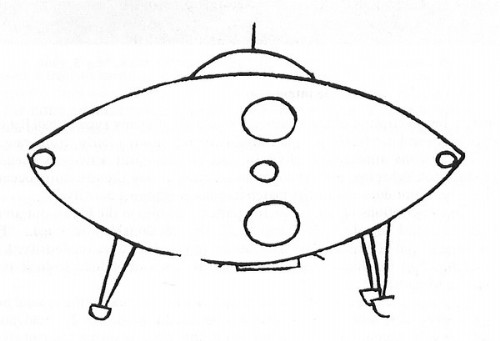UFO Case Report:
Burn marks and holes found after UFO seen close to ground
Date: September 13, 1966
Location: Gwinner, North Dakota, United States
Young Randy E. Rotenberger was waiting for the school bus outside his home when he saw "some flashing lights," then an object. "It looked like two bowls put together," the witness told an AP reporter. He saw three "pegs" on the bottom and antennae projecting from the top. Later, "some burnt marks" and tapered holes were found at the scene, each about a foot in diameter and five inches deep.

UFO which hovered just above ground at Gwinner, N.D., September 13,1966. Sketched by witness.
Classification & Features
Type of Case/Report: StandardCase
Hynek Classification: CE2
Special Features/Characteristics: Physical Trace, Witness Sketch, Landing, Children
Full Report / Article
Source: NICAP (National Investigations Committee on Aerial Phenomenon), 'Strange Effects from UFOs', by Donald Keyhoe and Gordon Lore
Air Force "Unidentified"
At 7:30 a.m., September 13, 1966, young Randy E. Rotenberger was waiting for the school bus outside his home in Gwinner, North Dakota. His mother was baby sitting and his father was at work in the Melroe Manufacturing Company, a farm equipment factory.
Randy saw "some flashing lights," then an object.
"It looked like two bowls put together," the witness told an Associated Press reporter.
He saw three "pegs" on the bottom and antennae projecting from the top of the silver-colored object. It also had red and green lights and was about eight feet thick. It was hovering just above the ground. Running into the house, Randy called his mother.
"The tone of his voice convinced me there was something wrong," Mrs. Emmanuel Rotenberger stated. "He was scared."
Mrs. Rotenberger told her son to lock the door and remain in the house. A moment later he called her back. He said the UFO was taking off and emitting a sound.
"I could hear a noise over the phone," Mrs. Rotenberger remarked. "It was a whirring sound."
The following day Randy and two friends inspected the area where the object was seen. They found "some burnt marks" and tapered holes, each about a foot in diameter and five inches deep. The holes formed a triangle. One side measured 26 feet, the second 23 feet and the third 22 feet.
Cliff Melroe, President of the Melroe Manufacturing Company, also inspected the holes.
"I've been around equipment all my life," Melroe stated. "Only a heavy piece of equipment could have made these prints. . . . Something made those holes other than someone trying to be funny."
Another of the witnesses to the physical evidence was General Homer Goebel, commander of the Fargo, North Dakota, Air National Guard base. General Goebel was not so impressed, however.
"There was a light rain at the time," he said. "There could have been . . . 'ball' lightning."
But the Air Force itself did not agree with the General.
"The .. . depressions in the ground . . . were compacted solidly," said Major James H. Aikman, of the Department of the Air Force, in a letter to NICAP. "For this reason, the sighting is carried as UNIDENTIFIED in Air Force files."
The official non-acceptance of the ball-lightning explanation in this case is reminiscent of the campaign of Philip Klass, an editor of Aviation Week and Space Technology, to explain most good UFO sightings as plasma/ball lighting. In an interview with the late Frank Edwards, famed news commentator and NICAP Board member, Klass publicly offered $10,000 to anyone who could prove the extraterrestrial theory of UFOs. Edwards countered by offering the same amount to Klass if he (Klass) could uncover a single report that the Air Force explained as ball lightning. The betting reached a stalemate.
Case ID: 578
edit: 578
FAIR
USE NOTICE: This page may contain copyrighted material the
use of which has not been specifically authorized by the
copyright owner. This website distributes this material without
profit to those who have expressed a prior interest in receiving
the included information for scientific, research and educational
purposes. We believe this constitutes a fair use of any such
copyrighted material as provided for in 17 U.S.C § 107.





